Barunguba Montague Island 360 experiences text version
Barunguba Montague Island Nature Reserve is a biodiversity hotspot. Explore our 360-degree interactive images to discover some of the unique animals and threatened species that live and breed here.
Read more about Barunguba Montague Island 360 experiences text version
This island off the NSW South Coast, near Narooma, has been declared an Asset of Intergenerational Significance (AIS) for its exceptional conservation value. Part of our commitment to zero extinctions of threatened species.
Gould’s petrel habitat
Gould’s petrel
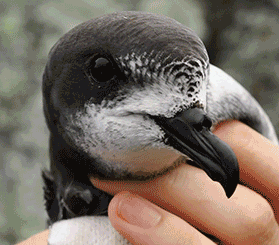
Barunguba Montague Island is the only place on the NSW South Coast that threatened Gould’s petrels breed – and one of the few places visitors can see them.
Each year, Gould’s petrel adults arrive on this island in October. They lay just a single egg in a hidden burrow. Both males and females incubate the eggs, which take up to 7 weeks to hatch. Parents feed their newly hatched chick a steady diet of small cephalopods and fish. By April, when the chick is 3 months old , it takes flight, or fledges, and spends most of its life “on the wing”. It may be years before a petrel will return to the island to find a mate and breed.
Watch our video story to learn more about Gould's petrel conservation on the island.
Photos: © David Gallan; © Nicolas Carlile; © Johny Spencer DCCEEW. Video: © David Gallan.
A new arrival
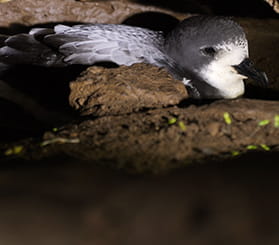
One of Australia’s rarest endemic seabirds, the Gould’s petrel was thought to only breed on the islands off Port Stephens. That is until 2012, when 2 were heard on Barunguba Montague Island, calling from a burrow. They’d never nested here before.
More breeding pairs have arrived since this first pioneering came along. Their presence is attributed to conservation efforts that have seen the main Port Stephens populations recover and expand their traditional breeding sites. Conservation work on Barunguba Montague Island, to restore seabird habitat and remove pest and weed species, has also helped make this location an attractive breeding site.
Photo: © David Gallan.
Artificial nest boxes
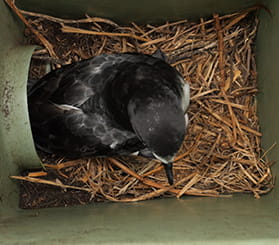
Artificial nest boxes were installed around the original Gould’s petrel burrow to provide additional nesting opportunities for new pairs. Surrounding these nest boxes, a loud speaker playing petrel calls was trialed in an attempt to attract more birds to the site.
The nest boxes have successfully been used by breeding pairs at Barunguba Montague Island and breeding sites on the islands off Port Stephens.
See our Gould's petrel nest boxes video. Photo: © David Gallan. Video: © David Gallan; Johny Spencer © DCCEEW.
Breeding success
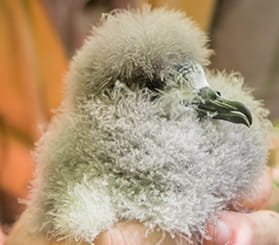
Gould’s petrel pairs on Barunguba Montague Island are breeding with good rates of success - over 80 chicks have fledged from the island. It’s hoped that these chicks return to breed in the coming years and are joined by new adults, to strengthen numbers of this threatened species and safeguard them against future threats.
Check out our burrow cam video of Gould's petrel chicks in their nest. Photo: Johny Spencer © DCCEEW. Video: © David Gallan.
Unique adaptations
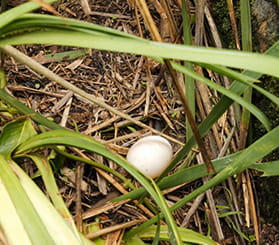
Gould’s petrel nests are found mainly across the northern end of the island, within rock cavities and beneath boulders. However, researchers have found that petrels on Barunguba Montague Island have adapted to also create burrows beneath native mat-rush shrubs and poa grasses. This is something they don’t do anywhere else.
Watch our burrow cam video of adult Gould's petrels in their rock burrow. Photo and video: © David Gallan.
Monitoring and leg banding

From October to March, known Gould’s petrel burrows and potential habitat are monitored for returning and new pairs. Today, there’s regularly over 40 breeding pairs visiting the island.
Leg banding of Gould’s petrel adults and chicks at all colonies in NSW is helping to shed light on individual birds movements, fidelity to their partners and colonies, and their longevity.
In 2021, an adult bird was found in one of the artificial nest boxes on Barunguba Montague Island. Amazingly, this bird had been banded as a chick on Cabbage Tree Island, off Port Stephens, way back in 2012. It had found its way south, across hundreds of kilometres of ocean. This confirmed the link between the Port Stephens populations as a source for birds on Barunguba Montague Island.
Leg banding is carried out under the Australian Bird and Bat Banding Scheme (ABBBS).
View our video of Gould's petrel monitoring and led banding. Photo and video: © David Gallan.
Safeguarding threatened species
All NSW islands that Gould’s petrels nest on, including Barunguba Montague Island, have been declared Assets of Intergenerational Significance (AIS), giving them strengthened protections to safeguard the future of this remarkable seabird.
Did you know? NSW National Parks and Wildlife Service (NPWS) is the first national park agency in Australia to set a zero extinctions target for threatened species, and one of the first in the world.
Around 85% of the approximately 900 threatened species in NSW are found in our national parks and reserves. This highlights the critical role of national parks in the conservation of threatened species.
Humpback whale
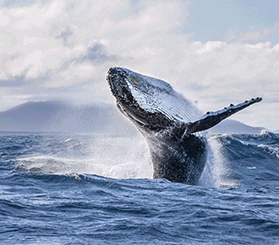
Between September and November you may see humpback whales pass near the island on their annual migration south. You can watch these gentle giants put on spectacular breaching and blowhole displays from land or on a whale watching and island tour.
Adults can be up to 18m long and weigh 50 tonnes. They ‘leap’ out of the water, roll in the air with huge pectoral fins stretched out like wings, then crash noisily back into the water. Scientists are still trying to figure out why humpbacks do this. It might be to clean pests from their skin or maybe it’s just fun. Watch video of a humpback whale breaching.
Because seasons are reversed on either side of the equator, northern and southern hemisphere populations of humpbacks probably never meet.
Photo: © David Rogers; Jonas Liebschner © DCCEEW; © Wayne Reynolds. Video: © iStock.com/crbellette
Batemans Marine Park
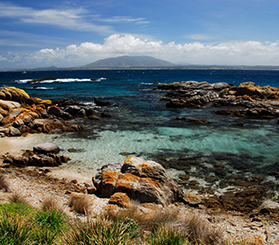
Batemans Marine Park surrounds Barunguba Montague Island and extends across 850 km2 of waters along the NSW South Coast. It includes islands, as well as rivers, estuaries, bays, lakes and lagoons along the mainland and up to 3 nautical miles offshore.
Batemans Marine Park features outstanding areas of rocky reef, kelp beds, seagrasses, sponge gardens, estuaries and open waters. Sustainable management of these habitats provides protection of vulnerable sites and species.
Photo: © Stuart Cohen and DCCEEW.
Lighthouse rocks area
NSW offshore islands
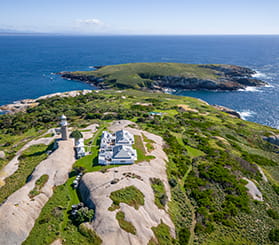
The NSW coastline has over 50 islands, supporting an amazing diversity of unique life often not found on the mainland. NSW National Parks and Wildlife Service (NPWS) manages many of these islands. They’re important for conserving Australia’s biodiversity, endemic and threatened species and sensitive ecosystems.
Barunguba Montague Island is the third largest island off the NSW coast, after Lord Howe Island and Brougton Island. It’s one of the few places in the world where visitors can enjoy a unique wildlife experience that includes more than 90 bird species, little penguins, fur seals, and whales in the one spot.
View our aerial drone video of Barunguba Montague Island. Photo: © Stuart Cohen and DCCEEW. Video: Johny Spencer © DCCEEW.
Crested terns
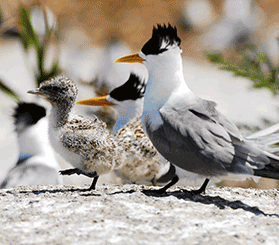
Crested terns breed on Barunguba Montague Island in dense groups in the spring and summer. Over 2, 500 pairs breed here - most of them choosing to nest around the lighthouse keepers’ cottages.
These seabirds are often seen fishing together within 25km of the island and returning to their nests with baitfish. Known for travelling in large groups, they keep their nests just out of reach from each other.
The island provides a vertebrate pest free nest site that’s vital for breeding success, and visitors to the island are kept away from tern colonies to minimise disturbance.
Watch our video of crested terns on the island. Photos: © Stuart Cohen and DCCEEW. Video: © David Gallan.
Silver gulls
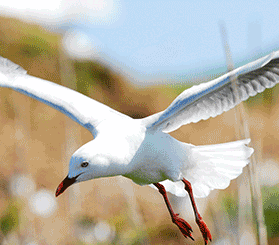
Silver gulls are widespread across Australia but prefer to nest on offshore islands including Barunguba Montague Island. Over 1,000 birds in their best breeding plumage return to the island in spring to nest amongst the grasses and shrubs.
SiIver gulls may have up to 4 chicks, which make a noisy addition to the island. They have a wide diet and are highly competitive when it comes to food, often attempting to steal fish from crested tern adults returning to feed their chicks.
Watch our video of silver gulls on Barunguba Montague Island. Photos: © Stuart Cohen and DCCEEW. Video: © David Gallan.
Island restoration project
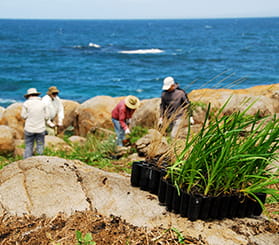
By the early 2000s, Barunguba Montague Island was suffering from habitat degradation due to goats, rabbits and mice trampling and reducing native vegetation cover. Kikuyu grass, introduced in the early 19th century to feed lighthouse keepers’ livestock, had smothered native plants and blocked penguins’ and shearwaters’ access to burrows.
In response, NSW National Parks launched an ambitious seabird restoration project on the island removed all the pest species, reduced the cover of weeds, and revegetated and restored large areas of habitat for nesting seabirds. Over 90,000 native seedlings have been planted on the island and native forest and shrublands are being restored.
The improvements have put back the very important understorey that little penguins need to nest beneath. New bird species are also attracted to the island.
Photo: © Stuart Cohen and DCCEEW.
White-faced storm petrels
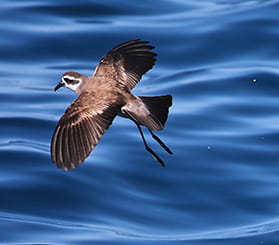
White-faced storm petrels are one of the more recent seabird species that’s been attracted to nest on the island. This tiny seabird prefers nesting beneath native seaberry saltbush, which is now increasing and forming large patches on the island. This habitat was previously trampled and heavily grazed by goats and rabbits. These pest animals are now removed from the island thanks to the successful Seabird Restoration Project.
Photo: © Manakin/Shutterstock.com.
Shearwaters
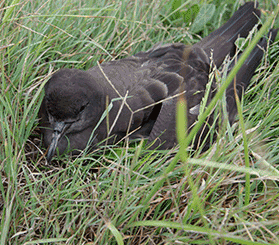
Amazingly, 3 species of shearwater nest on Barunguba Montague Island. These are mainly wedge-tailed and short-tailed shearwaters, with a small number of sooty shearwaters.
Also known as muttonbirds, an estimated 15,000 pairs of shearwaters breed on the island each year. All 3 species nest in deep soil burrows in mixed colonies, laying a single egg which is not replaced if lost. View night vision video of shearwaters nesting on the island.
Shearwater parents undertake amazing foraging flights to feed themselves and their chicks on Barunguba Montague Island. Short-tailed shearwaters cover up to 15,000km in these foraging flights.
Shearwaters breeding on Barunguba Montague Island have been the focus of one of the longest continuous seabird studies in the world, with the number of fledglings recorded since the early 1960s.
Photos: © Rosie Nicolai. Video: © David Gallan.
International recognition
Barunguba Montague Island Nature Reserve was one of the first sites in the world to be awarded International Union for Conservation of Nature (IUCN) Green List status, in 2014. This global certification program recognises and celebrates excellence in well managed protected and conserved areas.
Barunguba Montague Island represents an exceptional example of protected area management and conservation achievements.
Waterline habitat
Fur seals
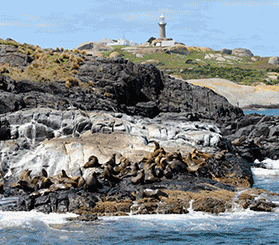
The island’s protected waters are a playground for hundreds of fur seals, which are listed as a vulnerable species in NSW. In fact, it’s home to the largest group of fur seals on the NSW coast.
There are around 200 annual residents, with seasonal seal numbers increasing to over 600 during spring.
View our video to see some of the island's fur seals at rest and play. Photos: © Stuart Cohen; © David Gallan; Johny Spencer © DCCEEW. Video: © David Gallan.
Top of the food chain
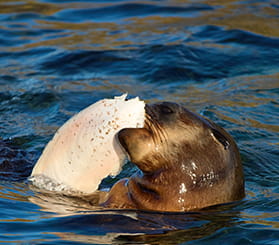
Australian fur seals are top of the food chain at Barunguba Montague Island Nature Reserve. This threatened species takes advantage of a lack of resident predators and the island’s prime position close to the continental shelf. The complex ocean currents make this area a rich hunting ground for seasonal seal treats, like baitfish and squid.
Photo: © David Gallan.
NSW’s only fur seal breeding site
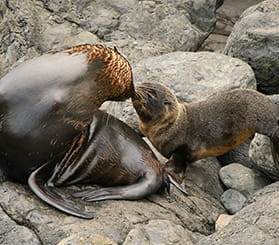
Barunguba Montague Island is the only breeding site in NSW for Australian and long-nosed fur seals. Pups are born from November to January and suckle their mother’s milk until 8 months old, when they learn to catch their own fishy meals.
To ensure the colony can breed without disturbance, public access and approach distances for people in the water, watercraft and drones is restricted. To see fur seal mums and pups safely enjoy our video.
Photo and video: © David Gallan.
Newborn seal pups
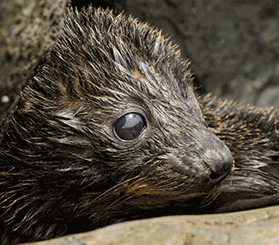
A newborn pup’s fur is not waterproof. Their coarse, waterproof fur develops from 6 weeks of age, and allows them to start exploring shallow waters surrounding the colony.
The shallow rock pools are safe spots to prepare pups for sea life. As they get older, pups become more adventurous, often playing and wrestling together as they become more manoeuvrable and faster in the water.
Check out our video of seal pups and juveniles. Photo and video: © David Gallan.
Cool customers
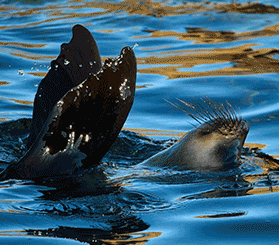
Fur seals spend more than half their lives in the water, diving up to 200m to catch fish, squid or octopus. They haul out on land but, like us, when they get hot they’ll go for a swim. You may see them in the waters around the island floating and frolicking. To cool down, they roll on their side at the water’s surface and stick a flipper in the air – it often looks like they’re waving.
Watch our fur seals water play video. Photo and video: © David Gallan.
Swim with seals
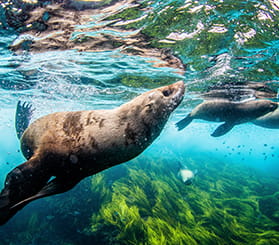
Visitors to South Coast NSW can take a boat tour to see threatened Australian fur seals in the waters surrounding Barunguba Montague Island. For an even more memorable experience, you can even snorkel and dive with these playful ‘sea puppies’.
Marine mammals including seals, whales and dolphins, are protected in NSW. Whether you’re swimming, sailing or paddling, you can help keep these animals safe by following NSW marine mammal minimum approach distances.
Photo: © Nicole McLachlan/Shutterstock.com.
March of the little penguins
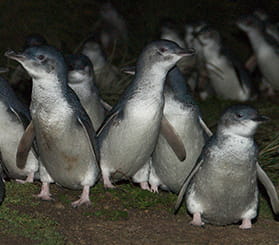
Barunguba Montague Island is home to an important breeding colony of little penguins. From September to January, you can join an evening tour to watch the nightly penguin procession, when these birds return to their burrows each evening after a busy day fishing in the waters in and around the island. Watch our night vision video of little penguins.
As the name suggests, little penguins are the smallest of the world’s penguin species, standing about 30cm tall. Their scientific name, Eudyptula minor, is Greek for “good little diver”.
Photos: © Stuart Cohen and DCCEEW. Video: © David Gallan.
Penguin parenting
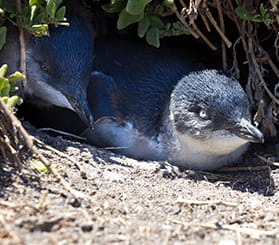
Around ??? penguin pairs breed on Barunguba Montague Island in hidden nests, not too far from the shoreline, beneath vegetation and within rock cavities. Females usually lay 2 eggs, with parents taking turn to incubate the eggs and perform chick raising duties. In a good year, both chicks will survive.
Little penguins are reliant on plentiful prey like small schooling fish, within 25km of the island. The surrounding waters, which are vital to this little penguin colony, are part of the Batemans Marine Park protected area.
Breeding success is also thanks to restoration efforts to remove introduced pest animals and invasive weeds in prime penguin habitat, plus the installation of nest boxes.
Watch our video of juvenile penguins and chicks on the island. Photo: © Eugene Sim/Shutterstock.com Video: © David Gallan.
Sooty oystercatchers
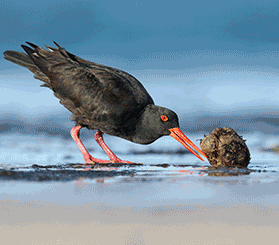
Sooty oystercatchers nest on Barunguba Montague Island during spring and summer. Unmistakable, with their black plumage and bright orange-red bill and eye-ring, this shorebird makes an inconspicuous nest in a rocky depression or shell-lined 'scrape' above the high tide waterline. Listed as a threatened species in NSW, disturbance during nesting, trampling of eggs, entanglement in discarded fishing tackle and introduced predators have reduced their numbers.
Barunguba Montague Island offers a pest free environment and restricts human access to protect breeding habitat. This species also forages on rock platforms on the mainland. Please lookout for them, and always control your dog around shorebirds and pick up discarded fishing tackle.
Photos: © Leo Berzins; © Isaac Wood; © Michael Jarman.
Intertidal zone
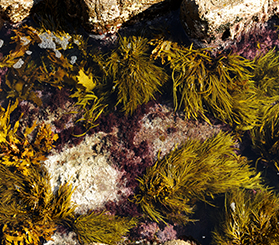
The Intertidal shoreline of the island is alive with life. Bright green and brown seaweeds dominate, interspersed with sponges, molluscs, Cunjevoi, tube worms, crabs, urchins, sea snails and sea stars.
When uncovered at low tide, these species endure hot sun exposure and powerful crashing waves. Some of these species are on the menu for the local threatened sooty oystercatchers .The intertidal zone is also a popular spot for fur seals to haul out on land.
Photo: © Stuart Cohen and DCCEEW.
Protecting our native animals and plants
While native plants and animals in NSW parks and reserves are protected under the National Parks and Wildlife Act 1974 and Biodiversity Conservation Act 2016, some threatened species like Gould's petrel, and their sensitive habitats, have been given extra protection as Assets of Intergenerational Significance.
